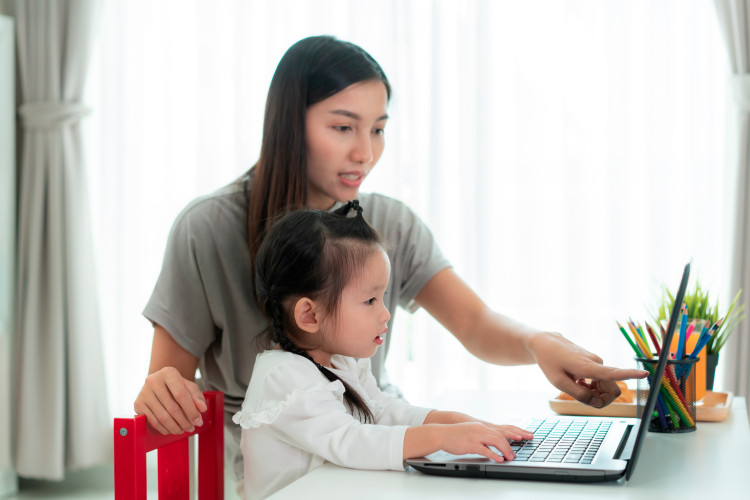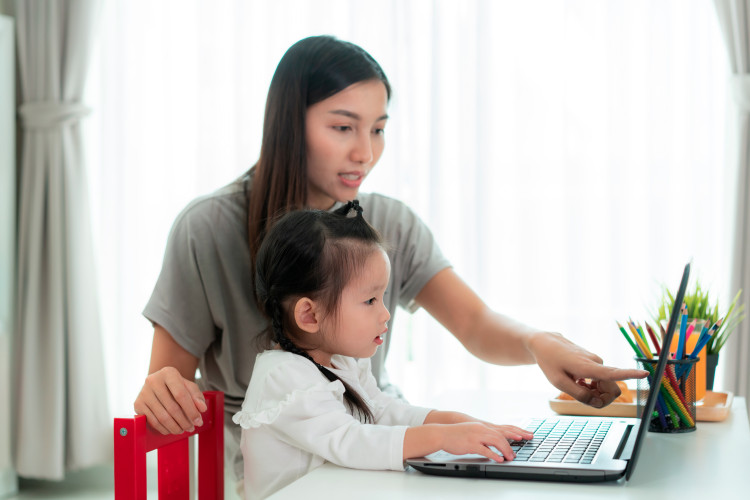Impact of Online Education on Families: Understanding the Transition to Remote Learning

With the onset of a global pandemic, families have adjusted to a rapid move to online education. According to the U.S. Census Bureau’s Household Pulse Survey, 93% of households with school-age children have had experience with some form of socially distant learning during the COVID-19 pandemic, with a majority of those households using some form of online learning.
For many families, the shift has been difficult. Issues of accessibility have impacted lower-income families disproportionally as they may not have access to two requirements for online learning: high-speed internet service and a computer. A National Education Association (NEA) report estimates that 13.5 million children ages 5-17 don’t have access to these technologies.
Families have also struggled to understand how online learning impacts the education and development of their children and overall family dynamics. As educators and parents have had some time to adjust to the upheaval that the pandemic has caused, both the advantages and disadvantages are becoming clearer. For instance, a joint study from the NEA and National PTA on the impact of online education found that most students feel they are getting a good education, despite feeling pressure from learning, emotional, economic, and health stressors.

Impact of Remote Learning on Children’s Education
In April 2020, which was when school closings in the U.S. peaked, approximately 55.1 million students were affected. Educators are still learning how the switch to online learning will affect students in the long term. Researchers worry about a “COVID-19 slide” that’s much like the “summer slide” — the learning loss students experience over the summer — but on a larger scale.
Parents are concerned, too. According to data from parents of K-12 students polled by the Pew Research Center:
- 65% of parents are concerned about their children possibly falling behind academically due to school disruptions and online learning.
- 63% of parents are concerned about their children having too much screen time.
- 60% of parents are concerned about their children being able to maintain social connections.
- 59% of parents are concerned about their children’s emotional well-being.
Factors that may determine how a student’s education fares during online learning include individual learning style, learning environment, and level of parental involvement. The most common reasons children have struggled with the change from the classroom environment include the following:
- Digital inequity. The children who have struggled the most lack access to consistent high-speed internet service and a one-to-one device for online learning. Successful online learning isn’t possible without these technologies, and millions of students simply don’t have them.
- Lack of structure. Many students perform best in a structured environment with a set routine. These students may be more distracted at home. They may skip assignments or class meetings, an action that can negatively impact online education. Many parents are working while their children engage in online learning. These families especially may struggle to offer the same level of structure at home that children get at school.
- Decreased engagement. Many students struggle with the lack of face-to-face interaction with their teachers and peers during online learning. Teachers may not be able to tell which students are on task and which students need more support. Disengaged students may not participate in class discussions online, and if a whole class is disengaged, that makes for one quiet, unproductive class meeting.
While the switch to online education has been hard for many, some students have thrived during the shift. Educators and parents alike are taking notice, with many considering how this could lead to permanent changes when students move back to the classroom. Teachers, parents, and students have seen some benefits of online learning, including the following:
- More flexible schedules. Many children struggle with an on-campus school day’s rigid schedule, which can negatively impact their grades and retention. These students may thrive on the flexibility that remote learning provides.
- More self-paced instruction. Some students may benefit from breaking assignments into manageable chunks and taking a break when needed, advantages not always available in an on-campus environment. During online learning, students find it easier to work at their own pace.
- Fewer distractions. Students who are easily distracted or anxious may find it easier to concentrate and focus on schoolwork at home. Shy students may struggle to answer questions or participate in class but find it easier to participate online.
- Improved self-regulation skills. Students are working more independently by tracking their schedules, remembering what time meetings are, setting time during the day to work on assignments, and tracking due dates.
- More sleep. Students are also benefiting from more sleep. One simple impact of online education is that children are better rested, which improves learning outcomes.
Impact of Online Education on Children’s Development
Beyond the educational impacts of online learning are its developmental impacts. Children learn much more than reading and math when they attend school in person; they also learn critical social and emotional skills they’ll carry into adulthood. As with educational performance, the switch to online education can affect children differently. Parents are right to wonder about the impacts on the social and emotional development of their children.
Social Development
Online education doesn’t offer the same social benefits that children receive when interacting with peers or teachers. Many parents are seeing the negative impacts of school disruptions and switch to remote learning. Children may be:
- Disengaged. Families are finding that many students are skipping classes or playing games instead of doing classwork. For many students, interacting with peers was the best part of school. Without that social connection, those students may struggle to remain engaged at all. Students may also have difficulty reading and communicating emotional cues via online video platforms.
- Isolated. Families worry that students are socially isolated during online learning. While many parents have worked to reduce the amount of time their children spend in front of a screen, those children may now spend several hours each day on a computer for school with little human interaction. The lack of one-on-one interaction can especially hinder younger students from developing social skills.
- Unmotivated. Peer relationships can foster a sense of motivation. When students work on group projects or presentations, or even just interact in class discussions, it can be motivating. When forced to work in isolation, they no longer have that motivation.
Other students may welcome the lack of social pressure that comes with online learning. The social aspect of the classroom can be a distraction for some students and anxiety inducing for others. Many children have flourished during online learning because they aren’t feeling the social pressure that comes with being on campus.
In particular, children who may be the victims of bullying at school have found online learning to be a welcome respite. Other students may feel relief from not having the pressure to look good or meet certain social expectations, and shy or anxious students may find it easier to reach out for teacher assistance. A lack of social activities such as clubs or sports teams can also allow students to focus more intensely on their schoolwork and improve their study habits.
Emotional Concerns
A big question parents may be asking is what the emotional impact of online education is on their children. The uncertainty and disruption of the pandemic, coupled with the subsequent shift to online learning, can take an emotional toll on children. Additionally, according to the National Survey on Drug Use and Health, 3.7 million children ages 12-17 receive mental health services at school, meaning that during the time many children may need help the most, they aren’t at school to receive it. The most pressing emotional concerns are:
- Depression. The social isolation a child may feel during online education can lead to depression. Additionally, children who get a lot of confidence from school may be struggling without the individual feedback they usually receive from teachers.
- Pandemic concerns. Children may be worried about themselves or family members contracting COVID-19. They may have loved ones who are sick with the virus or may have lost a family member.
- Financial worries. Some parents have lost their jobs or income because of COVID-19, a loss that stresses everyone in the household, including children.
Compound all these concerns with the disruption in routine that the switch to online learning has caused and it can be a lot for a child to handle. Parents want to support their children emotionally but may not know the best way to do that.
Impact of Virtual Schooling on Family Dynamics
When schools and businesses began shutting down in the early days of the COVID-19 pandemic, parents hastily transformed rooms in their homes to classrooms and offices. One child may work at a desk in a bedroom while another may use a table in the dining room for online classes. A parent or parents may also be trying to work remotely from other rooms in the home.
Parents have not only shifted the space in their homes but also taken on new roles as remote learning leaders or virtual learning teachers. According to a Learning Heroes survey, parents estimate that they spend an average of 2.5 hours each day helping their children with schoolwork, but this can vary based on the number and ages of children. Some parents have even left their jobs to devote time to supporting their children during online learning or supplementing school-provided lessons.
These drastic changes have stressed families already frazzled about health and financial security; however, many families are focused on the bright side. Positives include the following:
- Parents may feel more connected to their children’s day-to-day education.
- Parents may better understand what their children are learning.
- Parents may have a stronger understanding of their children’s academic strengths and weaknesses.
- Parents may have a closer relationship with their children’s teachers.
Resources for Navigating the Impact of Online Education
Parents are doing the best they can to manage a situation that remains uncertain and disruptive. Families want their children to succeed during remote learning, and some resources can help them achieve this. Parents should explore these resources for tips and tricks on navigating online learning.
- Common Sense, “Parent Tips and Tricks for Distance Learning”: Learn how to encourage and motivate children to succeed in online learning with these tips.
- Mom.com, “8 of the Best Virtual Learning Resources for Parents”: Discover parent-approved apps and websites to enhance online learning.
- New York Public Library, Remote Learning Resources: Kids & Teens: Delve into online education resources from the New York Public Library.
- Office of Elementary and Secondary Education, Resources for Parents and Families for Remote Learning: Explore ways to support children’s social, emotional, and behavior skills with these resources.
- U.S. News & World Report, “10 Teaching Resources for Parents During COVID-19”: Find additional resources to help children learn at home.
Online Learning Provides an Opportunity for Growth
Parents are concerned about the long-term effects of online learning on their children. The transition has disrupted education for children, as well as affected their social, emotional, and mental well-being. Parents are justifiably concerned about the negative effects of online learning, but there have also been some positive takeaways.
Parents, teachers, and students were blindsided when the pandemic forced schools across the country to close. Even as some schools have begun to reopen, others have remained closed and millions of students are still learning remotely to some degree. As the impact of online education becomes more apparent, families and educators can learn valuable information and use this as an opportunity to grow.

